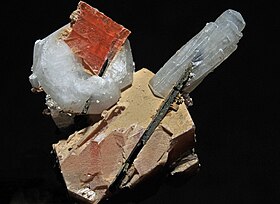naturally occurring. inorganic solid that has a definite chemical composition and possesses characteristic physical properties. Certain minerals are considered essential elements for tree growth and development.
A mineral is, broadly speaking, a solid chemical compound that occurs naturally in pure form. Minerals are most commonly associated with rocks due to the presence of minerals within rocks. These rocks may consist of one type of mineral, or may be an aggregate of two or more different types of minerals, spacially segregated into distinct phases. Compounds that occur only in living beings are usually excluded, but some minerals are often biogenic (such as calcite) and/or are organic compounds in the sense of chemistry (such as mellite). Moreover, living beings often synthesize inorganic minerals (such as hydroxylapatite) that also occur in rocks.
In geology and mineralogy, the term "mineral" is usually reserved for mineral species: crystalline compounds with a fairly well-defined chemical composition and a specific crystal structure. Minerals without a definite crystalline structure, such as opal or obsidian, are then more properly called mineraloids. If a chemical compound may occur naturally with different crystal structures, each structure is considered different mineral species. Thus, for example, quartz and stishovite are two different minerals consisting of the same compound, silicon dioxide.
The International Mineralogical Association (IMA) is the world's premier standard body for the definition and nomenclature of mineral species. As of November 2018, the IMA recognizes 5,413 official mineral species. out of more than 5,500 proposed or traditional ones.
The chemical composition of a named mineral species may vary somewhat by the inclusion of small amounts of impurities. Specific varieties of a species sometimes have conventional or official names of their own. For example, amethyst is a purple variety of the mineral species quartz. Some mineral species can have variable proportions of two or more chemical elements that occupy equivalent positions in the mineral's structure; for example, the formula of mackinawite is given as (Fe,Ni)
9S
8, meaning Fe
xNi
9-xS
8, where x is a variable number between 0 and 9. Sometimes a mineral with variable composition is split into separate species, more or less arbitrarily, forming a mineral group; that is the case of the silicates Ca
xMg
yFe
2-x-ySiO
4, the olivine group.
Besides the essential chemical composition and crystal structure, the description of a mineral species usually includes its common physical properties such as habit, hardness, lustre, diaphaneity, colour, streak, tenacity, cleavage, fracture, parting, specific gravity, magnetism, fluorescence, radioactivity, as well as its taste or smell and its reaction to acid.
Minerals are classified by key chemical constituents; the two dominant systems are the Dana classification and the Strunz classification. Silicate minerals comprise approximately 90% of the Earth's crust. Other important mineral groups include the native elements, sulfides, oxides, halides, carbonates, sulfates, and phosphates.

